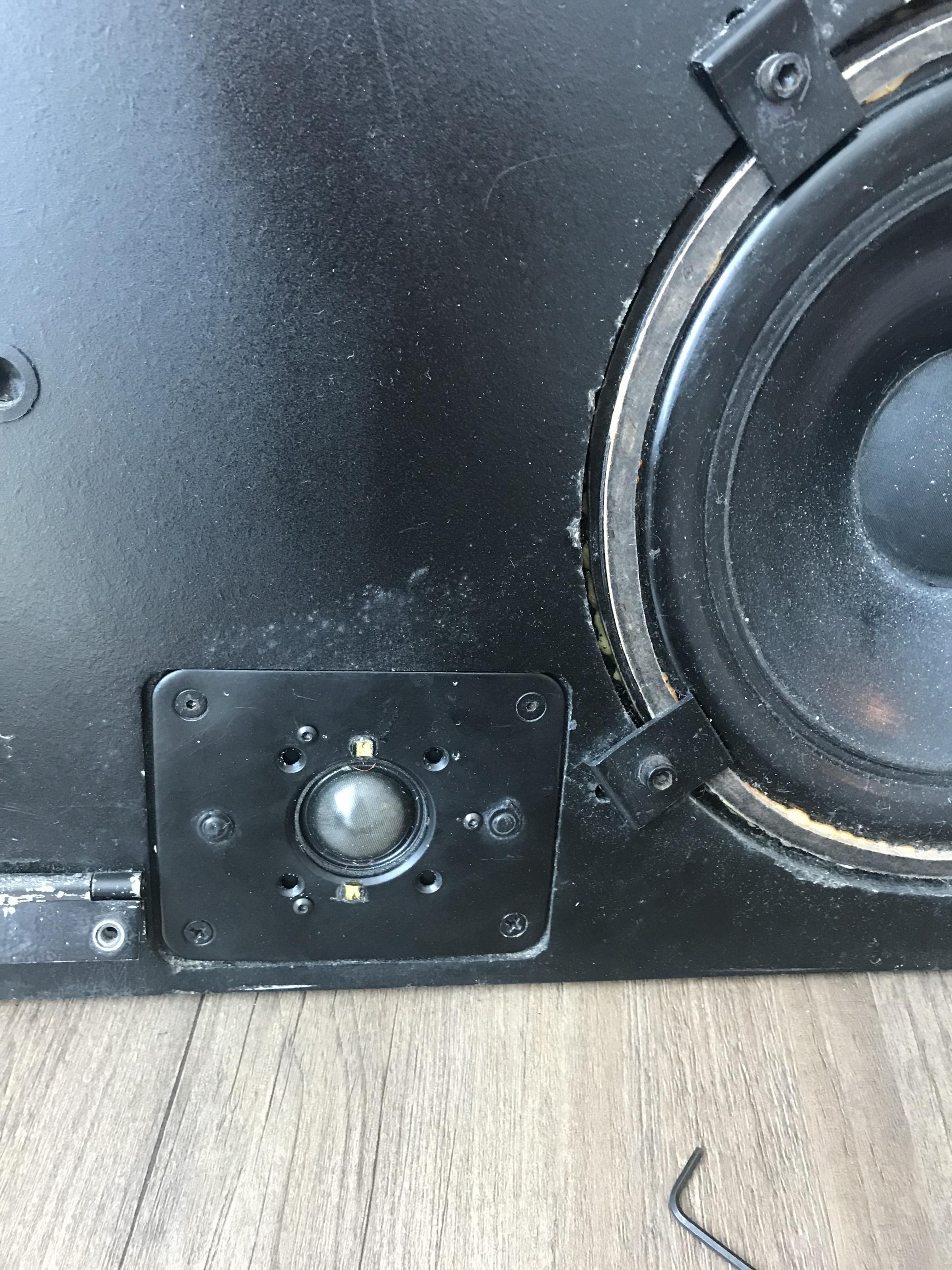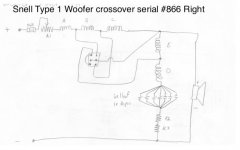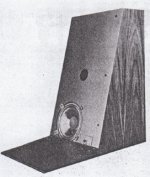When people are replacing tweeters, I usually start by saying measure the facia cutout and the rebate to see what will fit. This is to avoid excessive woodwork.
Next we want to know the DC resistance (3 or near 6 ohm) and dome type. Soft dome 1 1/8" here, I think.
Lastly I like to know the crossover, to judge how easily attenuation can be applied, because 1" domes vary between 88dB and 91dB output, but are usually flattish. Useful to know the bass size and DC resistance too, because there are only so many places to go with an 8" or 10". And Peter Snell often used 4 ohm bass.
Ah, that crossover. A strange animal. The bass section looks like it doesn't do much except apply a little bafflestep contour. The 3rd order tweeter section has the look of a 4 ohm 3kHz network with some heavy downward variable attenuation around 2.5kHz. I can't think what else a 2uF/2mH/8R adjustable trap would do.
Bypass capacitors are a bit idiosyncratic IMO. As are multiple small capacitors making a big one. Having multiple adjustments available always suggests a design that is plain wrong at some level to me. At heart it looks like quite a simple network. Simplifies roughly to bass coil and third order tweeter. The old 8" plus 1" style that works quite well.
I appreciate the attempt to work with room boundaries here, Allison effect an' all that, but clearly this design never really took off. Which brings us back to the tweeter replacement. I have the feeling you made it more difficult than it is.
You are right the first Morel replacement was too lightweight. The MDT29 aka CAT 298 is not an easy one either. It has a high Fs impedance and a sound I don't much like with its small chamber. Tweeter level is extremely sensitive to adjust. 1dB either way can make or break it. Which corresponds to 1R in the input resistor.
Hmm, bit of a ramble there. I'm not sure what my point is. 😱
Next we want to know the DC resistance (3 or near 6 ohm) and dome type. Soft dome 1 1/8" here, I think.
Lastly I like to know the crossover, to judge how easily attenuation can be applied, because 1" domes vary between 88dB and 91dB output, but are usually flattish. Useful to know the bass size and DC resistance too, because there are only so many places to go with an 8" or 10". And Peter Snell often used 4 ohm bass.
Ah, that crossover. A strange animal. The bass section looks like it doesn't do much except apply a little bafflestep contour. The 3rd order tweeter section has the look of a 4 ohm 3kHz network with some heavy downward variable attenuation around 2.5kHz. I can't think what else a 2uF/2mH/8R adjustable trap would do.
Bypass capacitors are a bit idiosyncratic IMO. As are multiple small capacitors making a big one. Having multiple adjustments available always suggests a design that is plain wrong at some level to me. At heart it looks like quite a simple network. Simplifies roughly to bass coil and third order tweeter. The old 8" plus 1" style that works quite well.
I appreciate the attempt to work with room boundaries here, Allison effect an' all that, but clearly this design never really took off. Which brings us back to the tweeter replacement. I have the feeling you made it more difficult than it is.
You are right the first Morel replacement was too lightweight. The MDT29 aka CAT 298 is not an easy one either. It has a high Fs impedance and a sound I don't much like with its small chamber. Tweeter level is extremely sensitive to adjust. 1dB either way can make or break it. Which corresponds to 1R in the input resistor.
Hmm, bit of a ramble there. I'm not sure what my point is. 😱
Attachments
Hmm, bit of a ramble there. I'm not sure what my point is. 😱
I had to consider the requirements of the cabinetry behind the magnet in that odd mounting location.
Thanks for your thoughts on design
Steve meant to say "Good Job."
🙂🙂🙂
I'm very happy with the result.
Funny, when I was a broke college student auditioning these speakers, they sounded much brighter than they do now.
Oh well, I guess age takes its toll (on me that is).
Yes, our Texan friend in this thread did OK with a Morel MDT29 aka CAT298.
Morel MDT 29 1-1/8" Soft Dome Tweeter

Morel have replaceable 28mm voicecoils and a removeable aluminium front plate with a 33mm aperture. The aperture just leaves room for the voicecoil leadouts to stand slightly proud. FWIW, you shouldn't try to pull off the voicecoil itself without unsoldering the very fine wires at the connector pins.
This is a 94mm tweeter, so I don't see anything hard about stretching the 90X110 mm rebate to fit. But using the original faceplate is evidently doable with three accurately drilled new holes .
It's a 89dB jobbie, which is actually lower than usual. But since you have some sort of level adjust, hardly a problem. I just got my own out of retirement, and they actually sound very nice on a 4th order filter, which I suppose deals with the highish 18 ohm Fs impedance well.
BTW, make a note of tweeter wiring and polarity when you disassemble. Saves some head-scratching later! LOL
And tell us how you get on.
Morel MDT 29 1-1/8" Soft Dome Tweeter
Morel have replaceable 28mm voicecoils and a removeable aluminium front plate with a 33mm aperture. The aperture just leaves room for the voicecoil leadouts to stand slightly proud. FWIW, you shouldn't try to pull off the voicecoil itself without unsoldering the very fine wires at the connector pins.
This is a 94mm tweeter, so I don't see anything hard about stretching the 90X110 mm rebate to fit. But using the original faceplate is evidently doable with three accurately drilled new holes .
It's a 89dB jobbie, which is actually lower than usual. But since you have some sort of level adjust, hardly a problem. I just got my own out of retirement, and they actually sound very nice on a 4th order filter, which I suppose deals with the highish 18 ohm Fs impedance well.
BTW, make a note of tweeter wiring and polarity when you disassemble. Saves some head-scratching later! LOL
And tell us how you get on.
Last edited:
I too am looking for a Type 1 tweeter replacement/repair. Anyone have any luck?
No real luck at all. The repair shop i found made something that didn't fit. And ultimately didn't meet the audio quality I expected.
So I did it myself as described in the thread.
system7 said:And tell us how you get on.
Thanks for the insight and encouragement.
I must say the Morels seem to be every bit as good as the dead tweeters ever were.
On initial listening, I thought I needed to increase their levels a bit. But then I put on several different records and liked what I heard.
So, I'm going to leave them alone for a while and not "cheese them out" avoiding the "more is better maxim!"
I too am looking for a Type 1 tweeter replacement/repair. Anyone have any luck?
BTW, I thought I knew all the Snell Type 1 owners worldwide! 🙂
Are you new, or a refugee from another forum?
Just a follow-up.
I thought the speakers sounded a bit dark with the new morel's and I didn't touch the crossovers.
But now I've jumped the tweeter resistors taking them out of the circuit.
These variable resisters were both set at about 1.1R.
Well, the Snells now sound like Snell's - bright and forward
Just kidding. They sound pretty good!
Maybe dial it back a little, but I'll leave it here and enjoy for now.
I thought the speakers sounded a bit dark with the new morel's and I didn't touch the crossovers.
But now I've jumped the tweeter resistors taking them out of the circuit.
These variable resisters were both set at about 1.1R.
Well, the Snells now sound like Snell's - bright and forward

Just kidding. They sound pretty good!
Maybe dial it back a little, but I'll leave it here and enjoy for now.
Hi!
iconic loudspeakers!
Some here claim that loudspeakers like that, with drivers just above the floor, inevitably set the soundstage accordingly - unrealistically low, just above the floor.
Can You please comment on that, as a user?
iconic loudspeakers!
Some here claim that loudspeakers like that, with drivers just above the floor, inevitably set the soundstage accordingly - unrealistically low, just above the floor.
Can You please comment on that, as a user?
Yes, the soundstage is oddly low. I find myself sitting forward and leaning downward sometimes. There is an obvious sweet spot that sounds amazing. I do get instruments and sounds that seem to be all around and outside of the loudspeakers at times - so happy with the overall imaging.
I think these loudspeakers sound very accurate, uncanny on some material. Maybe that's to do with the reduced floor reflections?
I think these loudspeakers sound very accurate, uncanny on some material. Maybe that's to do with the reduced floor reflections?
- Home
- Loudspeakers
- Multi-Way
- Rare Snell Type 1 - Broken Tweeter


